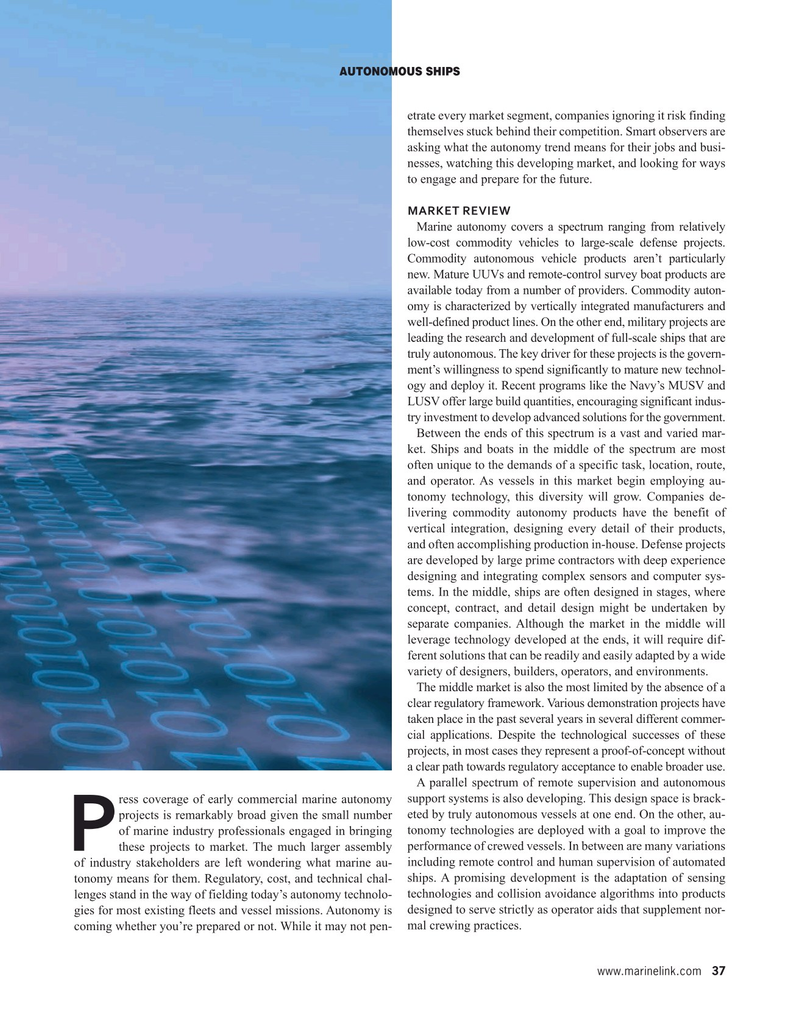
Page 37: of Maritime Reporter Magazine (July 2020)
Maritime Power Edition
Read this page in Pdf, Flash or Html5 edition of July 2020 Maritime Reporter Magazine
auTonoMous sHips etrate every market segment, companies ignoring it risk finding themselves stuck behind their competition. Smart observers are asking what the autonomy trend means for their jobs and busi- nesses, watching this developing market, and looking for ways to engage and prepare for the future.
MArket review
Marine autonomy covers a spectrum ranging from relatively low-cost commodity vehicles to large-scale defense projects.
Commodity autonomous vehicle products aren’t particularly new. Mature UUVs and remote-control survey boat products are available today from a number of providers. Commodity auton- omy is characterized by vertically integrated manufacturers and well-defined product lines. On the other end, military projects are leading the research and development of full-scale ships that are truly autonomous. The key driver for these projects is the govern- ment’s willingness to spend significantly to mature new technol- ogy and deploy it. Recent programs like the Navy’s MUSV and
LUSV offer large build quantities, encouraging significant indus- try investment to develop advanced solutions for the government.
Between the ends of this spectrum is a vast and varied mar- ket. Ships and boats in the middle of the spectrum are most often unique to the demands of a specific task, location, route, and operator. As vessels in this market begin employing au- tonomy technology, this diversity will grow. Companies de- livering commodity autonomy products have the benefit of vertical integration, designing every detail of their products, and often accomplishing production in-house. Defense projects are developed by large prime contractors with deep experience designing and integrating complex sensors and computer sys- tems. In the middle, ships are often designed in stages, where concept, contract, and detail design might be undertaken by separate companies. Although the market in the middle will leverage technology developed at the ends, it will require dif- ferent solutions that can be readily and easily adapted by a wide variety of designers, builders, operators, and environments.
The middle market is also the most limited by the absence of a clear regulatory framework. Various demonstration projects have taken place in the past several years in several different commer- cial applications. Despite the technological successes of these projects, in most cases they represent a proof-of-concept without a clear path towards regulatory acceptance to enable broader use.
A parallel spectrum of remote supervision and autonomous ress coverage of early commercial marine autonomy support systems is also developing. This design space is brack- projects is remarkably broad given the small number eted by truly autonomous vessels at one end. On the other, au- of marine industry professionals engaged in bringing tonomy technologies are deployed with a goal to improve the
Pthese projects to market. The much larger assembly performance of crewed vessels. In between are many variations of industry stakeholders are left wondering what marine au- including remote control and human supervision of automated tonomy means for them. Regulatory, cost, and technical chal- ships. A promising development is the adaptation of sensing lenges stand in the way of fielding today’s autonomy technolo- technologies and collision avoidance algorithms into products gies for most existing fleets and vessel missions. Autonomy is designed to serve strictly as operator aids that supplement nor- coming whether you’re prepared or not. While it may not pen- mal crewing practices.
www.marinelink.com 37

 36
36

 38
38
